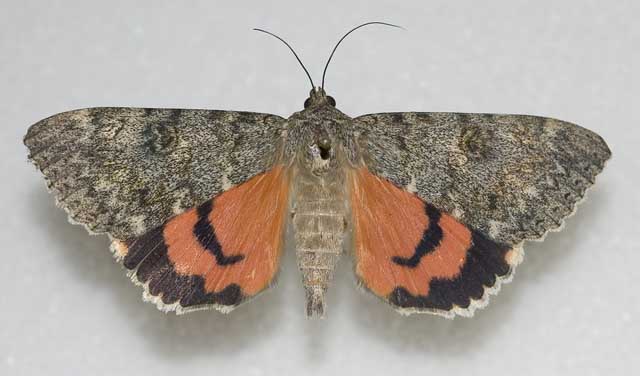Little Yellow-Orange Underwings: Wingspans: 35-65mm
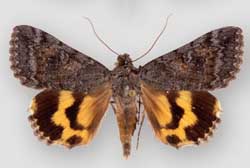
| Catocala chelidonia occidentalis;
43-47mm. Fw charcoal to brownish gray, mottled with hoary scales. Am, pm lines black,
modestly apparent. Subreniform spot whitish to yellow, usually visible.
Hw: many basal black scales/hairs, especially along i. m..
Wider inner band, narrower pm band, consistently darker yellowish color.
Anal spot separated from outer band.
|
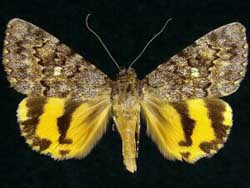
| Catocala benjamini mayhewi;
50 mm. Catocala benjamini reportedly flies as the nominate susbspecies in Arizona, Nevada, southern California and southern Utah.
Catocala benjamini mayhewi flies in southern California. Catocala benjamini jumpi
flies in the Kofa Mountains of Arizona. Catocala benjamini ute flies in
southeastern Utah in the Balaneed Rock Area at elevations around 1610 m.
|
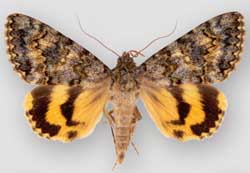 |
Catocala andromache.
Fw usually liberally speckled with greenish scales.
Catocala andromache sympatric with C. b. mayhewi along desert slopes of southern CA mountains.
The two species are consistently separated by larger size, darker forewings, darker yellowish bands,
and wider black bands of C. andromache.
|
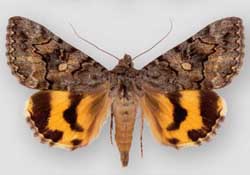 |
The dorsal forewing is mostly brown, mottled with dark patches. The reniform spot is dark filled while the subreniform
is closed and almost cream coloured. |
Catocala mcdunnoughi, David Hawks
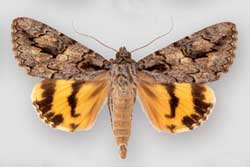 |
Catocala johnsoniana.
This species has a conspicuous basal dash, an open subreniform spot, and longer teeth in the pmline as compared to
C. californiensis.
The hindwing inner black band is relatively short and thick, while the postmedial yellow band is
proportionately wider than in most specimens of all other species in the C. delilah complex."
|
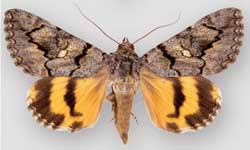 |
Basal dash lacking or very small.
Evenly ashy gray forewing with black lines. Am line thick, dark patch between reniform, subreniform, pm line
usually conspicuous.
|
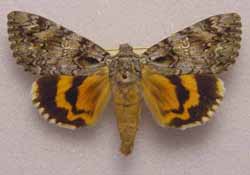
| Catocala ilia zoe male;
65mm. Fw light grey, considerable brown scaling. Double reniform spot brown center, thinly outlined in black,
widely outlined in white,
thinly outlined in black. Sbrnfrm spot indented both sides, just above tailed extension,
which may/may not be open.
Aml black, distinct, pointed, triangular shaped indentation just above im. Pml darker along upper half.
southern, western.
|
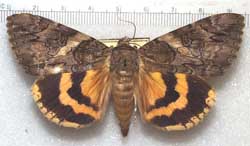
| Catocala piatrix dionyza;
68-84mm. Fw has light-colored band/bar extending from large, pale brown subreniform spot along am line to costa.
There is usually relatively dark area between reniform spot and pm line, wing veins tend to be dark and distinct there.
Hw fringe lightly barred, lighter than deeper orange on rest of wing.
|
Small-Medium Orange-Salmon Underwings: Wingspans: 65mm and under
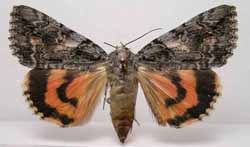
|
verrilliana; Verrill's Underwing;
45-60mm.
Closed, subtriangular subreniform spot large,
light in colour. Light patch runs from subreniform
diagonally to costa. Dark area on basal side of
aml, light patches between pml and subterminal line
distinguish this species. Note orange hw fringe. July-September, oaks.
|
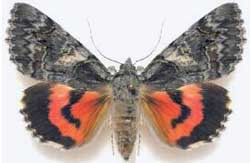
| Catocala ophelia;
Ophelia Underwing: 52mm:
Fw dark grey, am/pm lines
relatively smooth except for two jagged spikes in pm
near apex. Considerable brown shading outside
sbtrmnl line. Hw pink-deep red, black
median band constricted in
center, ending before im. Black
submarginal border broad near apex. White fringe
heavily checked. Southwestern
|
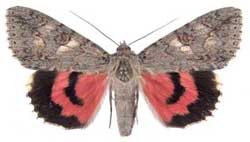
|
faustina cleopatra;
58 mm; Head and thorax dark bluish grey; abdomen brownish grey.
Primaries dark bluish grey. Transverse lines, reniform and sub-reniform indistinct with
some yellowish brown shading on upper surface.
Orange to pinkish hw with relatively narrow bands, fringe (unbroken) white on exterior margin, grey near abdomen.
|
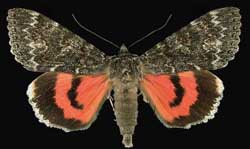
|
californica;
65mm.
Fws dark, gritty. Markings indistinct. Dark, large reniform spot; am and pm lines indistinct.
Subterminal line inwardly lined with light scales. Hw fringe white, checked halfway to outer edge with black,
black lines on veins extending through fringe. Some orange bleeding at apex. Black median band ends
well before im. June until August; willow or walnut??
|
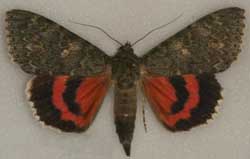
| Catocala hermia francisca;
Francisca Underwing: 58-68mm; pinkish-red:
subterminal line inwardly bordered with white. Dark areas along veins extending outwardly from reniform spot
often give the impression of three small black dots. Subreniform "pork chop" shape, lighter than surrounding areas,
extending as a line to pm line. Hw black median band relatively thick.
|
Medium Orange-Salmon Underwings: Wingspans: 65mm - 75mm
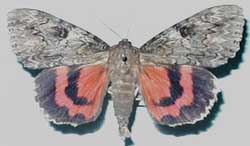
|
irene; Irene's Underwing;
65-75mm.
Fw grey brown, darker upper half basal area, around reniform spot, indistinct arc near apex.
Sbrnfrm spot lighter, open into pm area.
Hw median black band pointed before reaching im. Outer band scalloped near a. a..
Probably southeast; poplars, willows
|
Catocala irene, Santiago Canyon, August 8, 1943, Buckett & Bauer collection
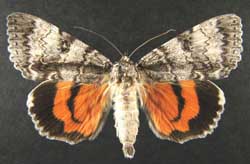
| **
semirelicta hippolyta; Hippolyta Underwing;
72-76mm.
White border just inside subterminal line. Pm uniformly zig-zag except for inward projecting "tooth" near anal angle.
Inner black band on scarlet hindwing very narrow, tapering to curved point,
terminating well before im. Fringe white, continuous from apex to anal angle.
|
Large Orange-Salmon Underwings: Wingspans: 75mm and larger
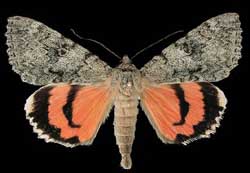
| Catocala junctura;
Joined Underwing; 67-85mm.
Fw is usually dark brownish-gray to evenly powdered
blue-grey w/o significant markings. Doubled reniform spot
often obscure. Thin, slightly darker am and pm
lines run from costa to im, not widely
spaced at im. Hw salmon/ orange-pink, narrow inner black band
turns in sharply, does not meet dark-haired im. May until October; poplars and willows.
|
Catocala junctura, Aliso Viejo, August 6, 2010, Kevin Lentz.
Catocala junctura, Laguna Hills, July 24, 2010, Kevin Lentz.
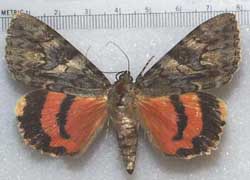
| Catocala jessica;
Jessica Underwing: 75mm: Fw is bluish grey with some brown scaling. Am line is irregular, meets i m almost at midpoint.
Pm line has one upper tooth produced, second is much less so. Third is little more than a sharp point
on smooth curve to fourth tooth, somewhat produced over opening of large subreniform spot.
Reniform spot is double and dark in darker region of median area.
|
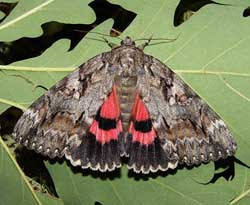
| aholibah;
80-90mm: Fw is mix of grey and brown, with preponderance of brown in subterminal area.
Double reniform spot has diffuse brown outline of inner oval. Subreniform spot is small,
distinctly outlined in black,
light coloured and does not connect to pm line. Upper two teeth of pm line are elongate
and are followed by relatively smooth line til next tooth below the subreniform spot.
Hindwing salmon or pinkish.
|
|
